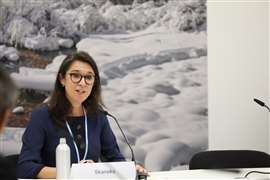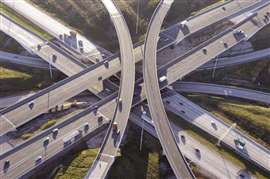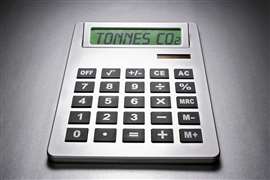Contractors grapple with scope 3 emissions
06 October 2023
Europe’s largest construction companies are coming under increasing pressure to cut the clouds of emissions produced by their suppliers and customers. But how can contractors even find out how much embodied carbon is in the materials they use - or persuade customers to use less energy in their buildings? Lucy Barnard reports.
When Lena Hök, executive vice president for Swedish construction company Skanska took to the stage to address world leaders at the COP26 climate change summit in Glasgow in 2021, her message was urgent.
“To achieve the objective of lowering CO2 emissions, innovation and partnerships with various players is required. Partnerships with many of you in this room: with companies and states that want to spearhead the transition, is key,” she told the assembly.
 Lena Hök, executive vice president for sustainability and innovation addresses COP26. Photo: Skanska
Lena Hök, executive vice president for sustainability and innovation addresses COP26. Photo: Skanska
“The large amount of emissions originates from production of materials such as concrete, steel and asphalt, as well as the use of buildings. Therefore, to reduce carbon emissions in the buildings and construction industry via increased transparency and cooperation is needed throughout the value chain.”
Skanska, which two years earlier had pledged to become ‘net zero’ by 2045, had already enjoyed considerable success in reducing its direct carbon emissions from its own building operations by nearly a half, cutting scope 1 and 2 emissions from 40,000 metric tons of carbon dioxide equivalent emissions in 2015 to just over 20,000mtCO2e in 2021.
However, as Hök pointed out, this figure was dwarfed by the enormous amount of indirect – or scope 3 – carbon emissions the company was also considered responsible for, which in 2021 alone stood at 1.7 million mtCO2e – 85 times higher.
The main reason for that, Hök said, was that scope 3 emissions take into account all the emissions indirectly created by a contractor – both those created by the manufacturers producing the steel and concrete which are eventually poured into buildings, but also those created by the people who will eventually use the buildings and infrastructure they have created – sometimes calculated for a period of 50 years.
Scope 3, a category, originally established by the Green House Gas Protocol in 1998, has become the standard way for organisations around the world to measure and report their carbon footprints, and means that for a contractor taking on the main building operations on a construction site, scope 3 emissions cover all the steps to get that building built and operating.
Until recently, most companies, including those in the construction industry, have tended to focus their carbon emissions reduction targets on their direct emissions such as the emissions they produced from construction machinery operating on sites, arguing that these are easier for them to both calculate and control.
Yet, as pressure from campaigners, consumers, employees, shareholders, funders and governments continues to mount on firms to reduce their overall carbon footprint, Europe’s largest construction companies are coming under increasing pressure to get to grips with indirect emissions too (see table).
This is especially the case for any company which wants to set an independently adjudicated ‘net zero’ emissions target, like Skanska, because a net zero target must include indirect emissions.
Net zero emissions targets must include scope 3
And Skanska is not alone. French contractor Vinci, which makes a large chunk of its earnings from designing, building and operating major infrastructure works such as airports, reports that in 2022, its scope 1 and 2 emissions accounted for 2.1 million mtCO2e while total scope 3 emissions came to 20 times that figure – 42 million mtCO2e.
Eiffage which similarly builds and owns infrastructure through concessions including airports and motorways, calculates that in its 2019 ‘base year,’ direct, scope 1 and 2 emissions accounted for 665,798 mtCO2e while scope 3 emissions accounted 40 times as much - 26.8 million mtCO2e.
The definition of Scope 3 emissions is laid out in the Greenhouse Gas Protocol, a joint initiative of World Resources Institute and the World Business Council for Sustainable Development. It specifies 15 categories, including purchased goods, waste generated, fuel related activities, use of sold products, investments, franchises and employee commuting.
Companies point out that for large organisations, tracking down all of these figures and ensuring that they are accurate can be a significant challenge.
In its 2022 Integrated Report, Bouygues says that one of its most immediate priorities of its climate strategy is for “more robust carbon audit calculations as well as product lifecycle assessments.” Currently, its calculations for the company’s 15 million mtCO2e carbon footprint include just scope 3a emissions (upstream emissions from suppliers). However, five of the company’s six business segments have already set targets to reduce scope 3 emissions and a sixth is in the process of setting one.
 Ferrovial says its work on infrastructure projects such as the 407ETR in Toronto (pictured) increase its scope 3 emissions count. Photo: Ferrovial
Ferrovial says its work on infrastructure projects such as the 407ETR in Toronto (pictured) increase its scope 3 emissions count. Photo: Ferrovial
Austria-based Strabag says that although it has yet to publish carbon footprint figures, its plan for becoming carbon neutral along its entire value chain by 2040 is to start with areas which it can easily control such as its own administration and then construction sites and then moving on to areas such as construction materials and infrastructure which are harder to directly control and less readily available at present.
Scope 3 emissions are open to a certain amount of interpretation. They can be calculated using one of four different methods: asking customers and suppliers to provide the information based on their own carbon data; calculating emissions based on the amount of cash spent by customers or with suppliers; using other activity data to assess carbon emissions; or, most likely, a combination of all of these.
For many of these calculations, companies are required to multiply spend or activity by an “emissions factor” to provide an estimate in metric tons of carbon dioxide equivalent – the standard measure for greenhouse gas emissions. There is no universal source of emissions factor and so companies must choose a suitable figure provided by government agencies, academic research, company reports or third-party standards organisations.
Nonetheless, Skanska reports that after starting to track its scope 3 emissions in 2020 when they stood at 1.95 million mtCO2e, the company succeeded in reducing them by 13.2% to 1.69 million mtCO2e in 2022.
Hök says that one of the ways it managed to do this was by developing its own specialist software to track and calculate embodied carbon in construction materials.
“Transparency on carbon emissions is needed throughout the value chain,” Skanska’s Hök says. “We have developed an Embodied Carbon in construction calculator –called EC3. It is an online tool that collects the carbon emissions data of thousands of building materials, allowing building developers, designers, and contractors to see the potential impact of their projects, and to compare materials to find ways of reducing embodied carbon. Our aim is that EC3 or similar tools will be used by the whole industry to understand and reduce carbon in the value chain.”
Specialist software tracks emissions
And other large contractors are taking similar steps. Eiffage says that in order to get a better handle on its upstream scope 3 emissions, which account for 12% of the group’s carbon footprint, the group’s purchasing department has started using carbon reporting software which it is currently refining to track physical shipments of goods, especially ready-mix concrete for which nearly 50% of group expenditure is now directly measured. Carbon calculator software uses carbon data from official sources such as the Ademe Carbon database and the Inies database to provide buyers with a double quote for each material, both in Euros and tons of carbon equivalent to highlight for customers the carbon savings of the different variants offered.
 Contractors are using carbon calculator software to record scope 3 emissions. Picture: Adobe Stock
Contractors are using carbon calculator software to record scope 3 emissions. Picture: Adobe Stock
Eiffage also says it is working to understand and compare the environmental performance of different construction materials and products. In 2022 the company developed Ecosource, an internal software tool designed to enable staff to estimate the carbon footprint of a potential project at the touch of a button.
Vinci estimates that 40% of its scope 3 emissions come from upstream activities such as materials purchasing while 60% comes from downstream activities, especially traffic on the 90 plus airports, highways and rail projects worldwide which the company operates through its Vinci Concessions branch.
It says that it has started using eco-design software, developed in partnership with the Mines ParisTech engineering school to predict and manage the energy consumption of delivered buildings.
And with more and more contractors under pressure to follow suit, Skanska’s Hök says that the need to both record and reduce scope 3 emissions across the entire construction value chain from manufacturers to occupiers is fundamentally changing the way the industry works.
“There is no more ‘Business as usual’. We as companies and public institutions are reshaping the basic principles of how buildings and infrastructure can be designed and built to lower carbon,” Hök said. “As we move forward, scaling these solutions will be critical for a full industry transformation.”
| Company | Scope 3 information |
| Bouygues |
Each of Bouygues six business segments is responsible for setting its own emissions target: Colas aims to reduce scope 3 emissions by 30% by 2030; Bouygues Immobilier plans to reduce them by 28%; Telecom by 17.5% by 2027; TF1 by 25% by 2030 and Bouygues Construction says that in buildings it aims for a 30% reduction in physical intensity and for civil works a 20% reduction in absolute terms by 2030. So far, Bouygues says it has only measured its scope 3a emissions – indirect upstream emissions. In scopes 1, 2 and 3a, Bouygues’ carbon footprint is a little more than 15 million tonnes of CO2e in 2022. The majority of emissions come from purchases made by the Group and the energy consumption of construction sites and installations. The construction businesses account for 93%. A total of 72% comes from materials and consumables |
| Eiffage |
Eiffage calculates that its direct scope 1 and 2 emissions from onsite implementation account for 3% of its carbon footprint. Upstream scope 3 emissions – such as production of materials equipment and services - account for 12% of the total. In 2019 they accounted for 4,250,000 mtCO2e. Downstream emissions were 22,560,000 mtCO2e. Downstream scope 3 emissions – when buildings are used by the client and other users – account for 85% of emissions (of which 10% are directly related to Eiffage’s activities). Eiffage plans to reduce upstream scope 3 emissions by 30% by 2030 (compared with 2019) by producing and using low carbon alternative materials. It plans to reduce its direct downstream emissions by 30% by 2030 with a range of solutions improving energy performance etc. |
| Ferrovial |
Ferrovial calculates its scope 3 emissions for 2022 stood at 3,995,293mtCO2e. The largest share of this was from investments – especially the company’s investments in UK airports over which it has no operational control (1,195,960mtCO2e). Purchased goods and services accounted for 867,951mtCO2e and capital goods made up 761,835mtCO2e. Use of sold products – emissions from the use of transport infrastructures especially motorways, managed by Cintra, made up 498,782 mtCO2e. The company’s target “contemplates” reducing its scope 3 emissions by 20% in absolute terms by 2030 excluding capital goods and purchased goods and services. |
|
Hochtief |
Hochtief aims to be climate neutral for scope 3 emissions by 2045. It aims to verify a net zero path – consistent with limiting temperature rise to 1.5% by the end of 2023. The company promises to evaluate the main emissions drivers for all scope figures. Subsequently, it will develop timelines and define roadmaps for achieving specific targets. These will determine when climate friendly alternatives can be deployed. |
| Skanska |
In 2022 Skanks’a scope 1 emissions stood at 164,000 mtCO2e and scope 2 emissions stood at between 36,000 and 18,000 mtCO2e depending on how you measured them. Scope 3 emissions were calculated as 1,688,000 mtCO2e. Skanska’s carbon footprint comprise: Sourcing of materials (49%), construction operations (10%) and the operational phase (41%) of our buildings and infrastructure. Scope 3 emissions can be divided into: Purchased goods and services (limited to cement, bitumen, concrete, steel and asphalt) 864,000mtCO2e; fuel 42,000; waste generated in operations 3,000; business travel (limited to air travel) 9,000 mtCO2e; and use of sold products 770,000mtCO2e. Skanska plans to reduce value chain emissions by 50% by 2030 compared with 2020. |
| Strabag |
In 2021, Strabag adopted its first corporate-wide sustainability strategy. As part of this strategy, the group commits to becoming climate neutral along the entire value chain by 2040 and laid out a pathway to reducing carbon emissions. Starting in 2025, it wants to first achieve its goal in five-year stages, starting with the goal of a climate-neutral administration, then moving on to climate-neutral construction sites, climate-neutral building operation and, from 2040, climate-neutral construction materials and climate-neutral infrastructure. |
| Vinci |
Vinci has set a target to reduce its indirect (upstream and downstream Scope 3 emissions) by 20% by 2030 compared to 2019. In 2022 Vinci produced 2.1 metric tons of CO2e for scope 1 and 2 and 42mtCO2e for scope 3 Around two fifths of scope 3 emissions came from traffic at concessions, especially airports, motorways and rail projects. Another fifth came from purchased materials and another 8% came from energy facilities |
STAY CONNECTED



Receive the information you need when you need it through our world-leading magazines, newsletters and daily briefings.
CONNECT WITH THE TEAM








